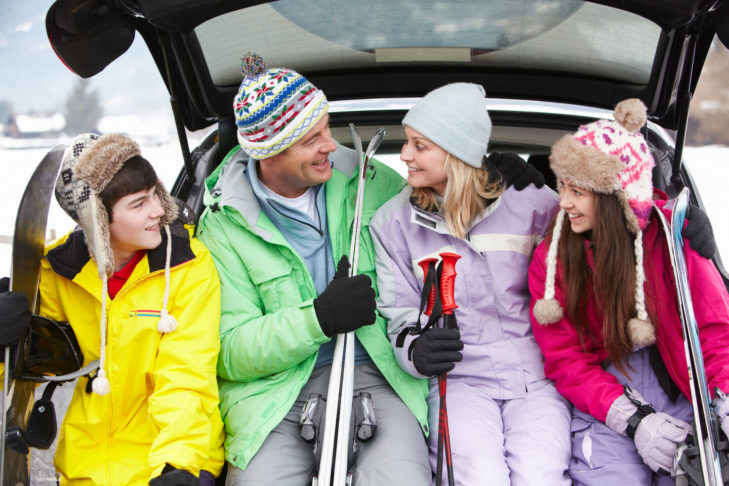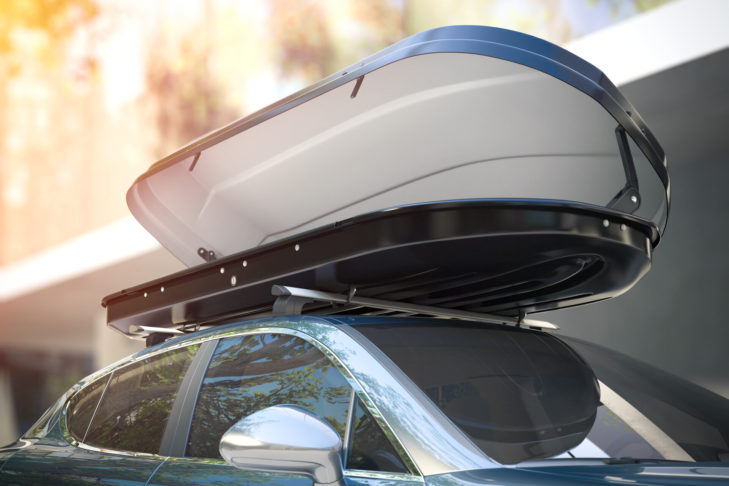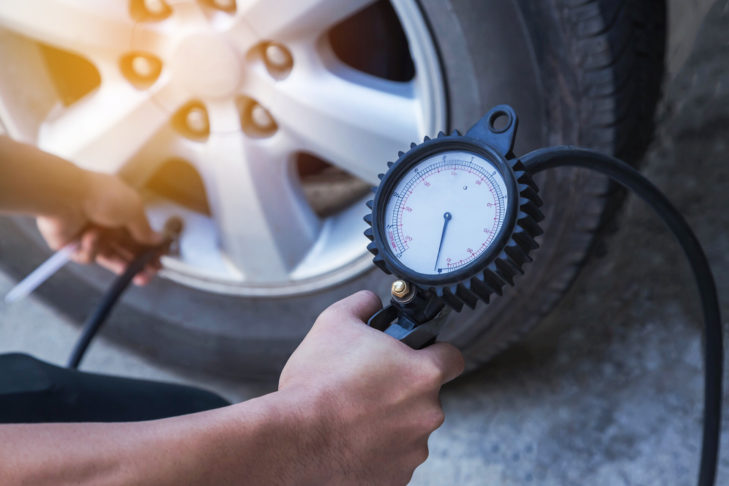As soon as the cold season approaches, winter sports enthusiasts look forward to hurtling down the freshly snow-covered slopes. But before setting off, your luggage and equipment for fun in the snow must first be safely stowed away for the journey. When packing for a skiing holiday, two things are particularly important: the equipment must be packed in such a way that it is neither damaged nor causing damage to other things and you must ensure that the equipment is positioned such that it will not cause an accident during transport. The latter mainly applies to transporting ski equipment in the car. SnowTrex shows you how to do this comfortably and as safely as possible when travelling to the ski resort.
Preparing for the flight
If you are flying on a ski holiday, you should clarify in advance with the airline what regulations apply to transporting ski equipment in your luggage. Many major airlines, such as Lufthansa, treat ski luggage as checked baggage. This means that you do not have to pay an extra charge for your sports equipment. In addition to the free baggage allowance, Lufthansa also allows ski equipment to be carried free of charge on most flights. Exceptions are flights from and to Central America. This currently applies to all fares except the Economy Class Light fare (as of 28/03/2018).
Airlines that operate with smaller aircraft or low-cost airlines such as Ryanair, however, charge an additional fee for ski luggage. It is advisable to ask the airline you have booked in advance how much the transport will cost and what requirements must be met.
In any case, it is advisable to pack as space-savingly as possible so that you do not have to check in another suitcase and also so that you have to transport as little luggage as possible. After all, ski equipment as such is not exactly light.
Transporting ski equipment with ski bags
Ski bags are therefore ideal for transporting equipment on the plane. They don’t weigh much, offer enough space and are made of waterproof material so that they protect the equipment well. Ski bags are available in various designs and price ranges.
The cheapest models have no protective padding and are more suitable for transporting equipment in the car. Padded bags are advisable for flights, as checked baggage can otherwise be easily damaged when loading and unloading the aircraft and on the baggage carousel. Padded ski bags are also available in a small version with simple padding for one pair of skis. These are usually carried over the shoulder. The larger ski bags with double padding hold up to four pairs of skis, offer a little more space and usually have wheels so that they can be transported more easily.
Ideal packing requires a little skill
The packing process varies slightly depending on the bag, but there are a few helpful tips. The skis should always be packed first. If you are taking a second pair of skis with you, place them on edge to the first pair on the two outer walls of the bag so that the underside of the skis is directly on the bag wall. This saves space and the skis are not directly on top of each other and are therefore better protected. Depending on the skis and the bag, you may have to try out a few positions until you find the ideal one. With larger bags, there is more space for more pairs of skis in the bottom of the bag and on the sides.
The next step is to pack your boots. The best way to save space is to place them at the top or bottom of the bag. To do this, place the first boot so that the sole is parallel to the top or bottom wall of the bag. Then place the second boot in the bag the other way round so that the two form a rectangle. This way, the bulky boots take up the least space. Repeat this if you are taking several boots with you.
The helmet goes at the other end. If you want, you can use the helmet as protection for your ski goggles or sunglasses. Simply place the goggles in the helmet and put your ski gloves over them as padding, for example. Have the hard side of the helmet face upwards and the gloves rest on the skis. The goggles are well protected in between and space is optimally utilised. By positioning the boots at one end and the helmet at the opposite end, the weight is distributed more evenly in the bag. This facilitates transport and helps prevent slipping of items.
Utilising storage space efficiently
The bulkiest and heaviest items now have their turn. The clothes can be placed between the bindings, preferably so that all the cavities are filled. To really make the most of the space, it is advisable to utilise every nook and cranny: For example, place the ski socks inside the boots. If you also roll your clothes tightly instead of folding them, you save space and also prevent them from creasing.
If you don’t want to check-in another suitcase, you can pack minimally and use packing cubes or vacuum bags. These compress the large volume of clothing into a very small space and are therefore very effective and space-saving. They also help you to organise your clothes neatly and are very light, so there is hardly any extra weight.
Last up are the ski poles. The safest and most space-saving way to store them is to place one pole on each outer wall. When closing the bag, you just have to make sure that you don’t put your weight on top of the bag. Many ski bags have additional pockets on the outside, offering extra storage space. This means you can store a lot. The ski bag including equipment is now packed and ready for your winter holiday.
The exact packing method also depends a little on the bag model. Some bags have separate compartments for ski boots, for example, while others have compression straps that compress the volume and thus save even more space.
In order to be able to use the ski bag for as long as possible, it should also be well looked after. It helps if the ski equipment is not placed in the bag while still wet or dirty. Ski bags can be cleaned well with a damp cloth. To avoid mould and bad odours, the bag should be left open in the fresh air for at least one day after use.
Safety first when transporting in the car
If you decide go to your ski holiday by car, you have several options: You can transport the equipment on the roof or in the car, i.e. on the back seat or in the boot. The advantage of transporting your equipment in the car is that it is protected from the wind and weather and you don’t have to carry an additional load on your roof. However, long skis in particular often pose a space problem. They can also obstruct the driver’s view, slide back and forth when turning corners, or even slide forwards when braking! As a result, they are not only potentially damaged, but also jeopardise the safety of the occupants and may cause accidents.
It is therefore particularly important to secure them, for example using seat belts, so that they do not move during the journey. It is also advisable to cover the back seat or the folded seats and the boot with a tarpaulin or blanket in advance. This protects the car from scratches and moisture. Before attaching the skis, the driver should check from the driver’s seat that the position of the skis indeed does not impair their view or their hands’ range of motion. Because once you have packed everything and then realise that you can’t see well, you have to start all over again. The skis can be stowed in a ski bag for protection. A ski bag can also be an advantage when travelling by car, especially if there isn’t much space. This way you can pack everything compactly and safely.
Transporting ski equipment on the roof: what to bear in mind
But not every car has space for skis. In a small car, there is often not enough space to transport ski equipment, even with the rear seats folded down. If there are also several people travelling in the car, it usually becomes too cramped. This is where a ski rack or roof box comes in handy.
Before buying a roof transport system for your equipment, you should take measurements. Especially for cars with a glass sliding roof, it is better if the glass remains free so as not to damage it. You should also check how much weight you are allowed to transport on the car roof. This varies depending on the car model: the maximum authorised roof load can be found in your car’s manual. The dimensions of the roof transport system are also important. According to EU road traffic regulations, the maximum width for loads on the roof is 2.55 metres. The height of the car including the roof load must not be higher than 4 metres and the roof load must not protrude too far to the front or rear. An excess of 2.50 metres is permitted at the front and 1.50 metres at the rear.
Ski racks for the roof: keeping everything protected
Some winter sports enthusiasts prefer ski racks as they are cheaper than a roof box and can transport up to six pairs of skis. However, you shouldn’t skimp on safety. There are ski racks that can be locked to protect your equipment from theft. Some ski racks even have magnetic devices that make them very easy to attach to the roof. But be careful! The magnets can easily scratch off the car’s paintwork. To avoid this, a thin layer of cling film can be placed under the magnets to protect the car.
This protects the car roof, but not the skis. With a ski rack, they are exposed on the roof. Especially in winter when driving through snow, slush and the splashing of road salt, the equipment can get dirty and even damaged. A waterproof ski bag offers good protection here. However, it is advisable to test this construction before buying – because it it is possible that the skis with ski bag will no longer fit in the ski rack.
The roof box
If you want to transport your equipment in a weatherproof manner on the roof of your car for your ski holiday, a roof box is a good idea. Although these are more expensive than ski racks, they also offer more protection as they can be completely locked. This protects the equipment from wind and winter weather. The roof box can also be used for roof transport outside the ski season, so the investment is often worthwhile.
There are a few important points to consider before buying. Not every roof box fits every car. You therefore need to make sure that the roof box is suitable for your car model. It is also important to secure the roof box correctly so that it does not slip or, even worse, fall off during the journey. It is best to follow the installation instructions exactly and check again after driving a few kilometres to make sure that everything is correctly fitted.
Stowing equipment in the roof box is very similar to packing a ski bag. Place long and heavy items such as skis at the bottom and bulky items such as shoes and helmets on the outside. Some roof boxes offer special holders for winter sports equipment. Fragile items should also be protected here, either by placing them in the helmet or wrapping them in a few layers of winter clothing. You can also wrap plastic bags around fragile items to protect them. It is also possible to line the roof box with a blanket so that objects do not slip and are lightly padded. The spaces in between can be easily filled with some clothing.
As soon as everything is stowed away, the tensioning straps can be fastened. The weight should be checked again with a scale before mounting on the roof to ensure that the authorised roof load is not exceeded. The roof box is not a suitcase or additional storage space for bags. It should only be used for stowing and securing bulky items, as otherwise the permitted weight can quickly be exceeded. It is therefore primarily used to stow items that have no room in the car and then to distribute and, if necessary, pad them so that they do not slip.
Your car must also be safely prepared for the journey
Before setting off, check the tyre pressure again with the total weight of the car and readjust the height of the headlights if necessary. This is because the roof load can push the car down, which, depending on the distribution of the weight, may cause the headlights to be lowered or raised, thereby either reducing your visibility or dazzling oncoming drivers. The pressure in the tyres must therefore be increased accordingly.
Driving with a roof box on the car is also different. The braking distance is longer and the car leans more when cornering. More volume on the roof also offers more resistance to the airstream – you can feel and hear this in the car. If you notice that the car is becoming very wobbly, you should therefore slow down. It’s better to prioritize driving slower to therefore reach your destination safely.
FAQ’s on the safe transport of ski equipment
Which ski bag is the right one?
This depends on the equipment and the means of transport. A ski bag with double padding is recommended for travellers taking more than one pair of skis with them or travelling by plane. A simple, waterproof ski bag without padding is sufficient for transporting ski equipment in the car.
Is there an additional charge for ski bags when flying?
This varies depending on the airline. Large airlines such as Lufthansa often do not charge an additional fee, while smaller airlines or budget airlines usually charge a surcharge. It is advisable to enquire individually before travelling.
How can you safely stow fragile items when packing?
Padded ski bags offer good protection against possible external damage. If you pack fragile items such as goggles in your ski bag, you can protect them well by stowing them in the helmet and padding them with additional clothing.
Can the ski equipment be transported in the car?
If the car is big enough and there is room for the ski equipment in the vehicle, there is no reason not to. However, it should be noted that large, bulky items must be secured very well so that they do not slip, get damaged, injure passengers or cause an accident when turning corners, for example.
What legal regulations must be observed when transporting ski equipment on the roof?
The authorised roof load must not be exceeded. This varies depending on the vehicle. Information on this can be found in your car’s handbook/manual. In addition, the car with roof load must not exceed a height of 4 metres and must not protrude more than 2.50 metres to the front and 1.50 metres to the rear.
Do I need a roof box to transport ski equipment on the roof?
No, because you can also transport skis on the roof using a ski rack. However, as the racks offer no protection from wind and weather, a ski bag is recommended to give your equipment this external protection.
Does every roof box fit every car?
No! Roof boxes are usually designed for specific car models. Before buying, you should therefore make sure that the roof box is suitable for your own vehicle.










